BIOH12008: Disease Awareness Pamphlet Project on Rheumatoid Arthritis
VerifiedAdded on 2023/05/30
|15
|4482
|244
Project
AI Summary
This project, completed for the BIOH12008 Human Pathophysiology course, focuses on creating a disease awareness pamphlet for Rheumatoid Arthritis. It includes five interview summaries about the clinical model, exploring public understanding of the disease's symptoms, causes, impact on quality of life, affected populations, diagnosis, and treatment. The interviews reveal varying levels of knowledge, highlighting areas for improved awareness. The project also includes five interview sheets about a draft disease awareness pamphlet, gathering feedback on its clarity, design, and effectiveness in conveying information. The analysis provides insights into public perceptions of Rheumatoid Arthritis and the effectiveness of educational materials, with the goal of improving patient education and awareness. The student has compiled the results of the interviews and provided a detailed analysis of their findings, including the strengths and weaknesses of the draft pamphlet. The project demonstrates the student's ability to conduct research, analyze data, and create educational materials related to a complex medical condition.
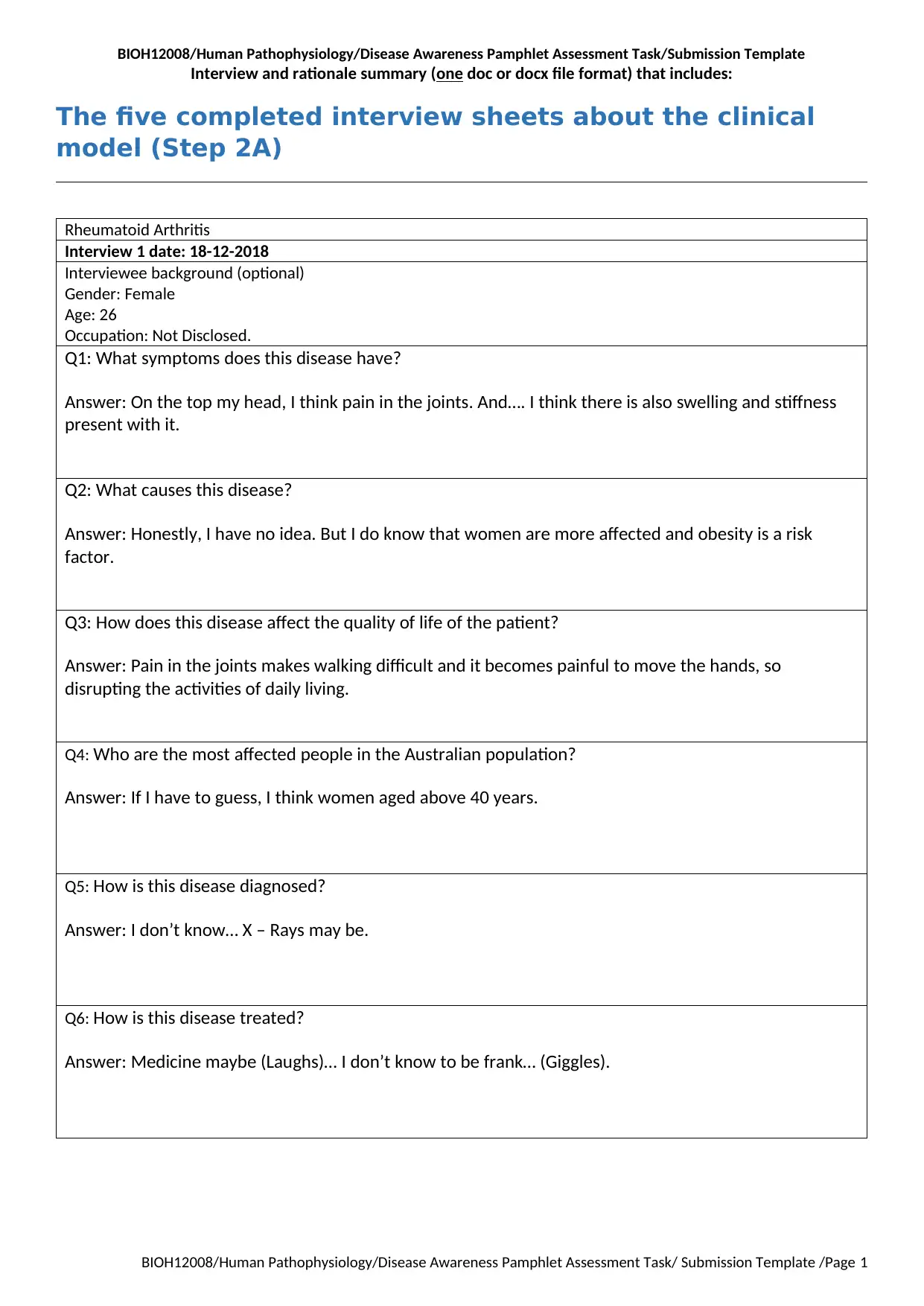
BIOH12008/Human Pathophysiology/Disease Awareness Pamphlet Assessment Task/Submission Template
Interview and rationale summary (one doc or docx file format) that includes:
The five completed interview sheets about the clinical
model (Step 2A)
Rheumatoid Arthritis
Interview 1 date: 18-12-2018
Interviewee background (optional)
Gender: Female
Age: 26
Occupation: Not Disclosed.
Q1: What symptoms does this disease have?
Answer: On the top my head, I think pain in the joints. And…. I think there is also swelling and stiffness
present with it.
Q2: What causes this disease?
Answer: Honestly, I have no idea. But I do know that women are more affected and obesity is a risk
factor.
Q3: How does this disease affect the quality of life of the patient?
Answer: Pain in the joints makes walking difficult and it becomes painful to move the hands, so
disrupting the activities of daily living.
Q4: Who are the most affected people in the Australian population?
Answer: If I have to guess, I think women aged above 40 years.
Q5: How is this disease diagnosed?
Answer: I don’t know… X – Rays may be.
Q6: How is this disease treated?
Answer: Medicine maybe (Laughs)… I don’t know to be frank… (Giggles).
BIOH12008/Human Pathophysiology/Disease Awareness Pamphlet Assessment Task/ Submission Template /Page 1
Interview and rationale summary (one doc or docx file format) that includes:
The five completed interview sheets about the clinical
model (Step 2A)
Rheumatoid Arthritis
Interview 1 date: 18-12-2018
Interviewee background (optional)
Gender: Female
Age: 26
Occupation: Not Disclosed.
Q1: What symptoms does this disease have?
Answer: On the top my head, I think pain in the joints. And…. I think there is also swelling and stiffness
present with it.
Q2: What causes this disease?
Answer: Honestly, I have no idea. But I do know that women are more affected and obesity is a risk
factor.
Q3: How does this disease affect the quality of life of the patient?
Answer: Pain in the joints makes walking difficult and it becomes painful to move the hands, so
disrupting the activities of daily living.
Q4: Who are the most affected people in the Australian population?
Answer: If I have to guess, I think women aged above 40 years.
Q5: How is this disease diagnosed?
Answer: I don’t know… X – Rays may be.
Q6: How is this disease treated?
Answer: Medicine maybe (Laughs)… I don’t know to be frank… (Giggles).
BIOH12008/Human Pathophysiology/Disease Awareness Pamphlet Assessment Task/ Submission Template /Page 1
Paraphrase This Document
Need a fresh take? Get an instant paraphrase of this document with our AI Paraphraser
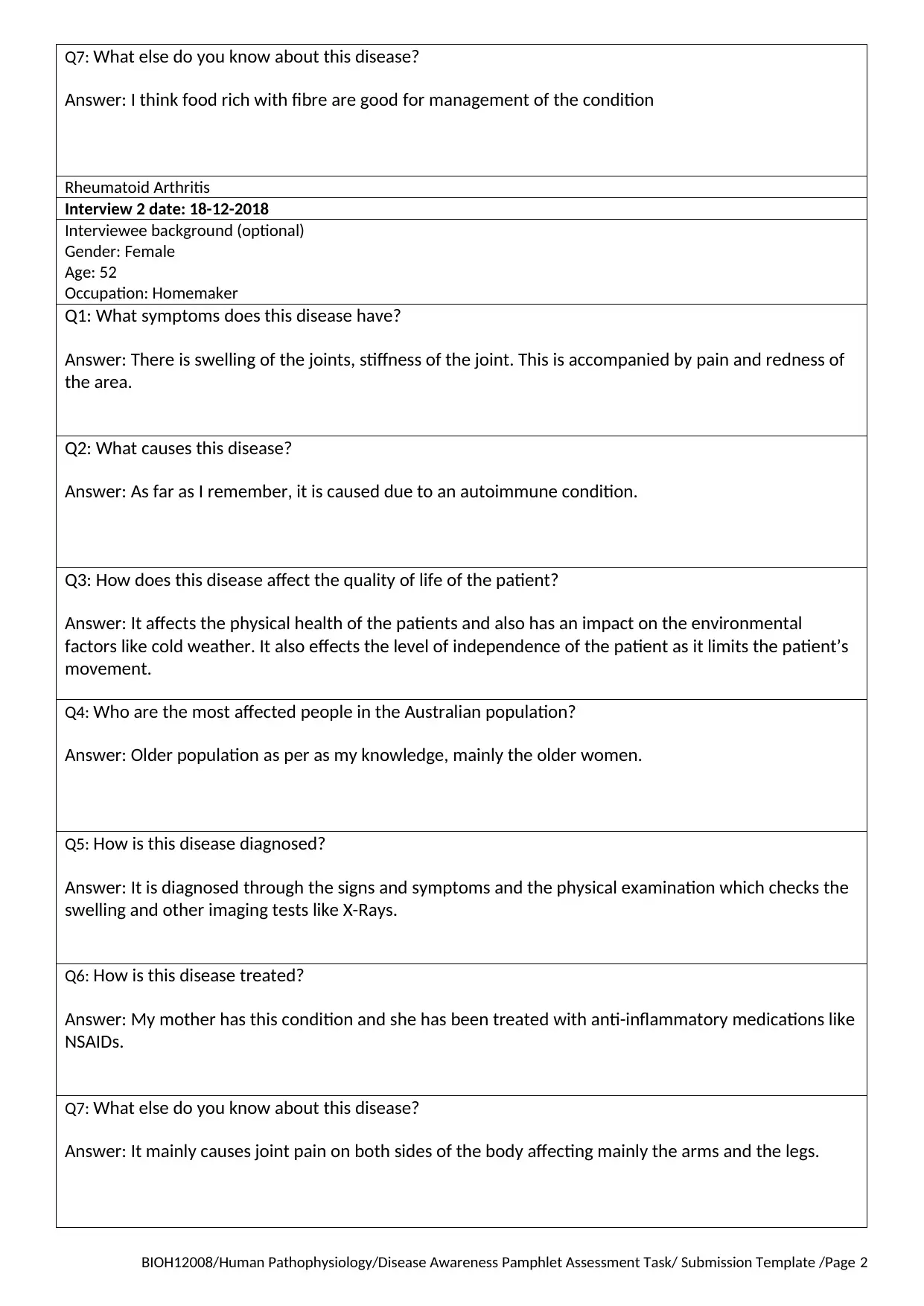
Q7: What else do you know about this disease?
Answer: I think food rich with fibre are good for management of the condition
Rheumatoid Arthritis
Interview 2 date: 18-12-2018
Interviewee background (optional)
Gender: Female
Age: 52
Occupation: Homemaker
Q1: What symptoms does this disease have?
Answer: There is swelling of the joints, stiffness of the joint. This is accompanied by pain and redness of
the area.
Q2: What causes this disease?
Answer: As far as I remember, it is caused due to an autoimmune condition.
Q3: How does this disease affect the quality of life of the patient?
Answer: It affects the physical health of the patients and also has an impact on the environmental
factors like cold weather. It also effects the level of independence of the patient as it limits the patient’s
movement.
Q4: Who are the most affected people in the Australian population?
Answer: Older population as per as my knowledge, mainly the older women.
Q5: How is this disease diagnosed?
Answer: It is diagnosed through the signs and symptoms and the physical examination which checks the
swelling and other imaging tests like X-Rays.
Q6: How is this disease treated?
Answer: My mother has this condition and she has been treated with anti-inflammatory medications like
NSAIDs.
Q7: What else do you know about this disease?
Answer: It mainly causes joint pain on both sides of the body affecting mainly the arms and the legs.
BIOH12008/Human Pathophysiology/Disease Awareness Pamphlet Assessment Task/ Submission Template /Page 2
Answer: I think food rich with fibre are good for management of the condition
Rheumatoid Arthritis
Interview 2 date: 18-12-2018
Interviewee background (optional)
Gender: Female
Age: 52
Occupation: Homemaker
Q1: What symptoms does this disease have?
Answer: There is swelling of the joints, stiffness of the joint. This is accompanied by pain and redness of
the area.
Q2: What causes this disease?
Answer: As far as I remember, it is caused due to an autoimmune condition.
Q3: How does this disease affect the quality of life of the patient?
Answer: It affects the physical health of the patients and also has an impact on the environmental
factors like cold weather. It also effects the level of independence of the patient as it limits the patient’s
movement.
Q4: Who are the most affected people in the Australian population?
Answer: Older population as per as my knowledge, mainly the older women.
Q5: How is this disease diagnosed?
Answer: It is diagnosed through the signs and symptoms and the physical examination which checks the
swelling and other imaging tests like X-Rays.
Q6: How is this disease treated?
Answer: My mother has this condition and she has been treated with anti-inflammatory medications like
NSAIDs.
Q7: What else do you know about this disease?
Answer: It mainly causes joint pain on both sides of the body affecting mainly the arms and the legs.
BIOH12008/Human Pathophysiology/Disease Awareness Pamphlet Assessment Task/ Submission Template /Page 2
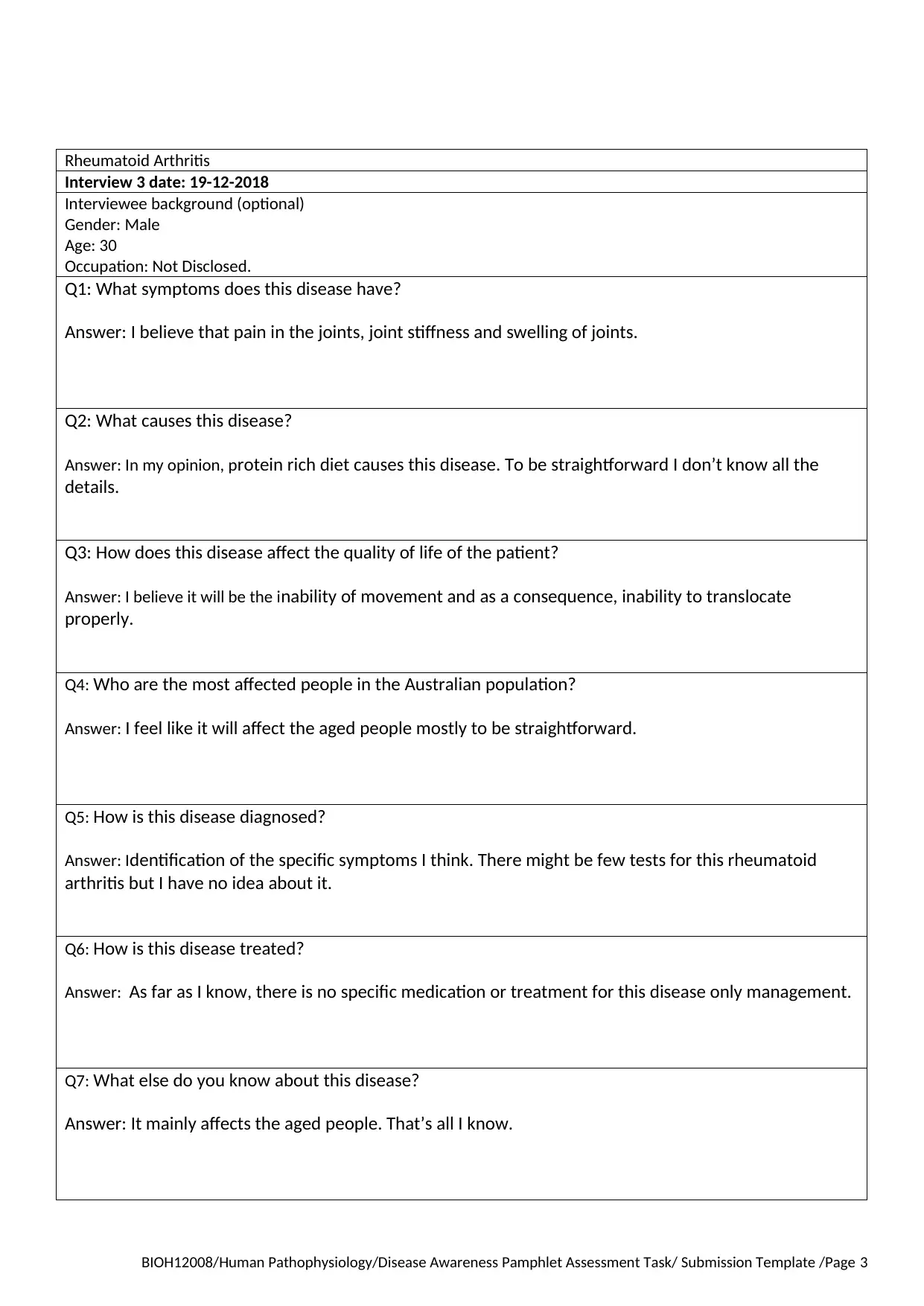
Rheumatoid Arthritis
Interview 3 date: 19-12-2018
Interviewee background (optional)
Gender: Male
Age: 30
Occupation: Not Disclosed.
Q1: What symptoms does this disease have?
Answer: I believe that pain in the joints, joint stiffness and swelling of joints.
Q2: What causes this disease?
Answer: In my opinion, protein rich diet causes this disease. To be straightforward I don’t know all the
details.
Q3: How does this disease affect the quality of life of the patient?
Answer: I believe it will be the inability of movement and as a consequence, inability to translocate
properly.
Q4: Who are the most affected people in the Australian population?
Answer: I feel like it will affect the aged people mostly to be straightforward.
Q5: How is this disease diagnosed?
Answer: Identification of the specific symptoms I think. There might be few tests for this rheumatoid
arthritis but I have no idea about it.
Q6: How is this disease treated?
Answer: As far as I know, there is no specific medication or treatment for this disease only management.
Q7: What else do you know about this disease?
Answer: It mainly affects the aged people. That’s all I know.
BIOH12008/Human Pathophysiology/Disease Awareness Pamphlet Assessment Task/ Submission Template /Page 3
Interview 3 date: 19-12-2018
Interviewee background (optional)
Gender: Male
Age: 30
Occupation: Not Disclosed.
Q1: What symptoms does this disease have?
Answer: I believe that pain in the joints, joint stiffness and swelling of joints.
Q2: What causes this disease?
Answer: In my opinion, protein rich diet causes this disease. To be straightforward I don’t know all the
details.
Q3: How does this disease affect the quality of life of the patient?
Answer: I believe it will be the inability of movement and as a consequence, inability to translocate
properly.
Q4: Who are the most affected people in the Australian population?
Answer: I feel like it will affect the aged people mostly to be straightforward.
Q5: How is this disease diagnosed?
Answer: Identification of the specific symptoms I think. There might be few tests for this rheumatoid
arthritis but I have no idea about it.
Q6: How is this disease treated?
Answer: As far as I know, there is no specific medication or treatment for this disease only management.
Q7: What else do you know about this disease?
Answer: It mainly affects the aged people. That’s all I know.
BIOH12008/Human Pathophysiology/Disease Awareness Pamphlet Assessment Task/ Submission Template /Page 3
⊘ This is a preview!⊘
Do you want full access?
Subscribe today to unlock all pages.

Trusted by 1+ million students worldwide
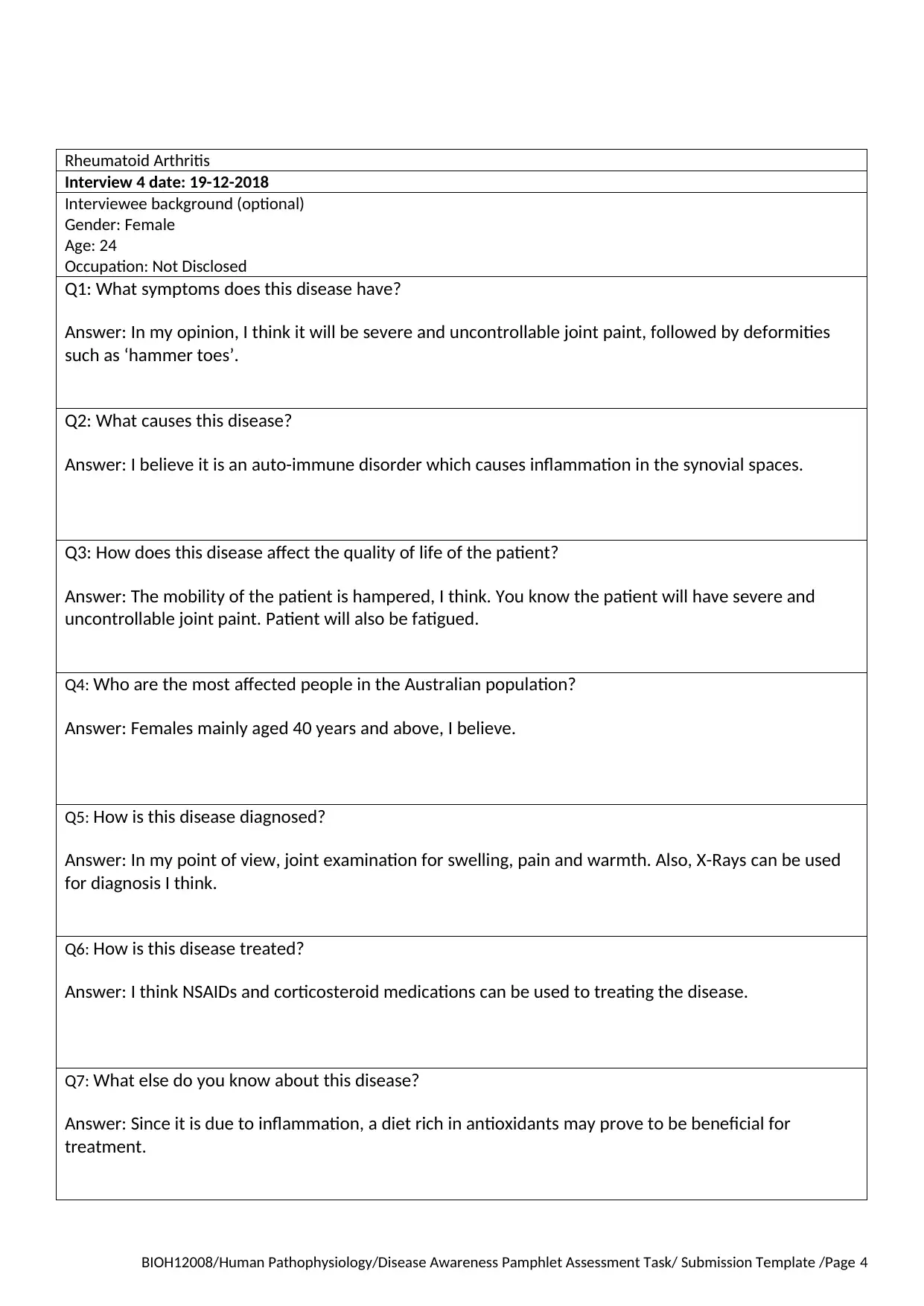
Rheumatoid Arthritis
Interview 4 date: 19-12-2018
Interviewee background (optional)
Gender: Female
Age: 24
Occupation: Not Disclosed
Q1: What symptoms does this disease have?
Answer: In my opinion, I think it will be severe and uncontrollable joint paint, followed by deformities
such as ‘hammer toes’.
Q2: What causes this disease?
Answer: I believe it is an auto-immune disorder which causes inflammation in the synovial spaces.
Q3: How does this disease affect the quality of life of the patient?
Answer: The mobility of the patient is hampered, I think. You know the patient will have severe and
uncontrollable joint paint. Patient will also be fatigued.
Q4: Who are the most affected people in the Australian population?
Answer: Females mainly aged 40 years and above, I believe.
Q5: How is this disease diagnosed?
Answer: In my point of view, joint examination for swelling, pain and warmth. Also, X-Rays can be used
for diagnosis I think.
Q6: How is this disease treated?
Answer: I think NSAIDs and corticosteroid medications can be used to treating the disease.
Q7: What else do you know about this disease?
Answer: Since it is due to inflammation, a diet rich in antioxidants may prove to be beneficial for
treatment.
BIOH12008/Human Pathophysiology/Disease Awareness Pamphlet Assessment Task/ Submission Template /Page 4
Interview 4 date: 19-12-2018
Interviewee background (optional)
Gender: Female
Age: 24
Occupation: Not Disclosed
Q1: What symptoms does this disease have?
Answer: In my opinion, I think it will be severe and uncontrollable joint paint, followed by deformities
such as ‘hammer toes’.
Q2: What causes this disease?
Answer: I believe it is an auto-immune disorder which causes inflammation in the synovial spaces.
Q3: How does this disease affect the quality of life of the patient?
Answer: The mobility of the patient is hampered, I think. You know the patient will have severe and
uncontrollable joint paint. Patient will also be fatigued.
Q4: Who are the most affected people in the Australian population?
Answer: Females mainly aged 40 years and above, I believe.
Q5: How is this disease diagnosed?
Answer: In my point of view, joint examination for swelling, pain and warmth. Also, X-Rays can be used
for diagnosis I think.
Q6: How is this disease treated?
Answer: I think NSAIDs and corticosteroid medications can be used to treating the disease.
Q7: What else do you know about this disease?
Answer: Since it is due to inflammation, a diet rich in antioxidants may prove to be beneficial for
treatment.
BIOH12008/Human Pathophysiology/Disease Awareness Pamphlet Assessment Task/ Submission Template /Page 4
Paraphrase This Document
Need a fresh take? Get an instant paraphrase of this document with our AI Paraphraser
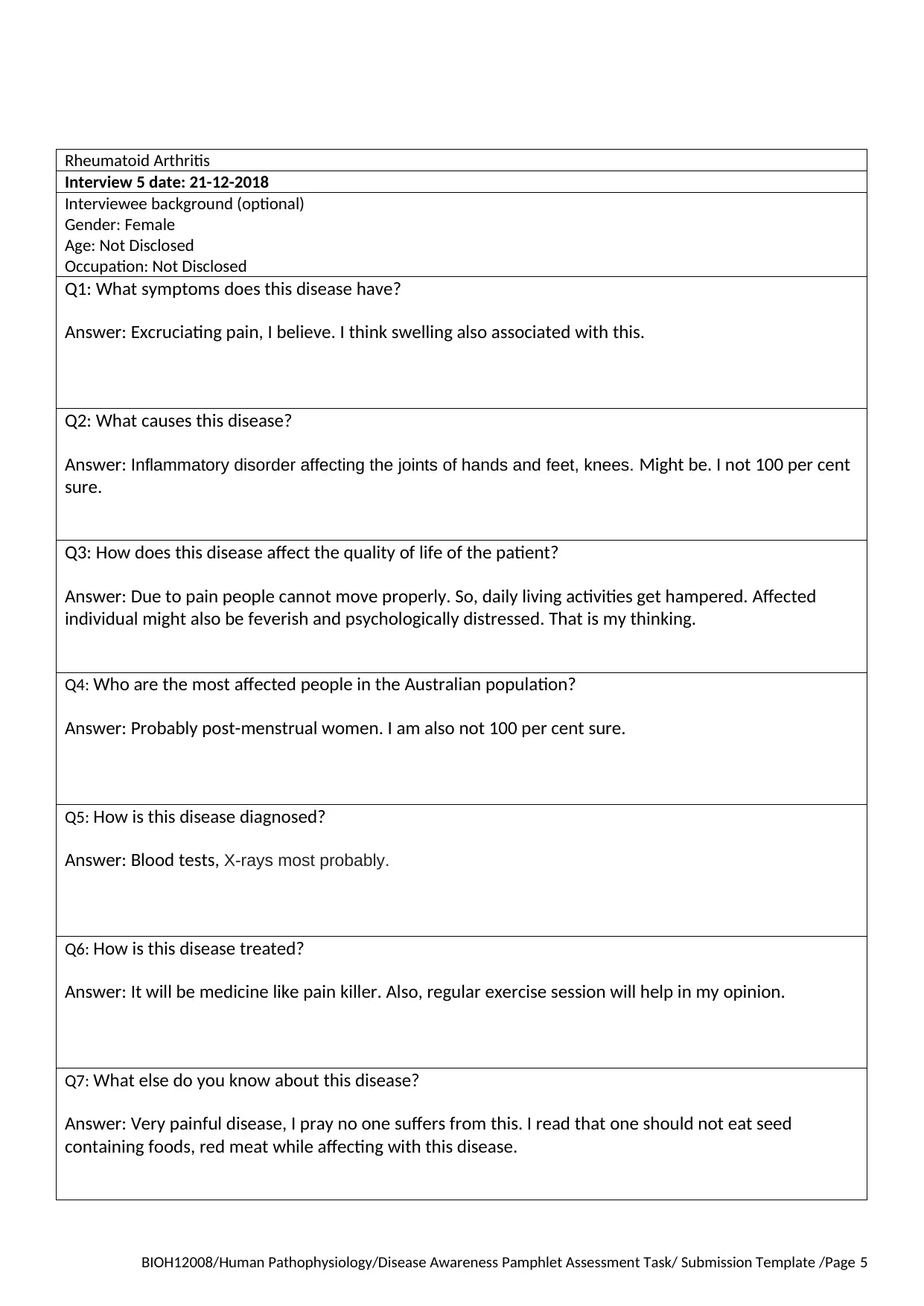
Rheumatoid Arthritis
Interview 5 date: 21-12-2018
Interviewee background (optional)
Gender: Female
Age: Not Disclosed
Occupation: Not Disclosed
Q1: What symptoms does this disease have?
Answer: Excruciating pain, I believe. I think swelling also associated with this.
Q2: What causes this disease?
Answer: Inflammatory disorder affecting the joints of hands and feet, knees. Might be. I not 100 per cent
sure.
Q3: How does this disease affect the quality of life of the patient?
Answer: Due to pain people cannot move properly. So, daily living activities get hampered. Affected
individual might also be feverish and psychologically distressed. That is my thinking.
Q4: Who are the most affected people in the Australian population?
Answer: Probably post-menstrual women. I am also not 100 per cent sure.
Q5: How is this disease diagnosed?
Answer: Blood tests, X-rays most probably.
Q6: How is this disease treated?
Answer: It will be medicine like pain killer. Also, regular exercise session will help in my opinion.
Q7: What else do you know about this disease?
Answer: Very painful disease, I pray no one suffers from this. I read that one should not eat seed
containing foods, red meat while affecting with this disease.
BIOH12008/Human Pathophysiology/Disease Awareness Pamphlet Assessment Task/ Submission Template /Page 5
Interview 5 date: 21-12-2018
Interviewee background (optional)
Gender: Female
Age: Not Disclosed
Occupation: Not Disclosed
Q1: What symptoms does this disease have?
Answer: Excruciating pain, I believe. I think swelling also associated with this.
Q2: What causes this disease?
Answer: Inflammatory disorder affecting the joints of hands and feet, knees. Might be. I not 100 per cent
sure.
Q3: How does this disease affect the quality of life of the patient?
Answer: Due to pain people cannot move properly. So, daily living activities get hampered. Affected
individual might also be feverish and psychologically distressed. That is my thinking.
Q4: Who are the most affected people in the Australian population?
Answer: Probably post-menstrual women. I am also not 100 per cent sure.
Q5: How is this disease diagnosed?
Answer: Blood tests, X-rays most probably.
Q6: How is this disease treated?
Answer: It will be medicine like pain killer. Also, regular exercise session will help in my opinion.
Q7: What else do you know about this disease?
Answer: Very painful disease, I pray no one suffers from this. I read that one should not eat seed
containing foods, red meat while affecting with this disease.
BIOH12008/Human Pathophysiology/Disease Awareness Pamphlet Assessment Task/ Submission Template /Page 5

BIOH12008/Human Pathophysiology/Disease Awareness Pamphlet Assessment Task/ Submission Template /Page 6
⊘ This is a preview!⊘
Do you want full access?
Subscribe today to unlock all pages.

Trusted by 1+ million students worldwide
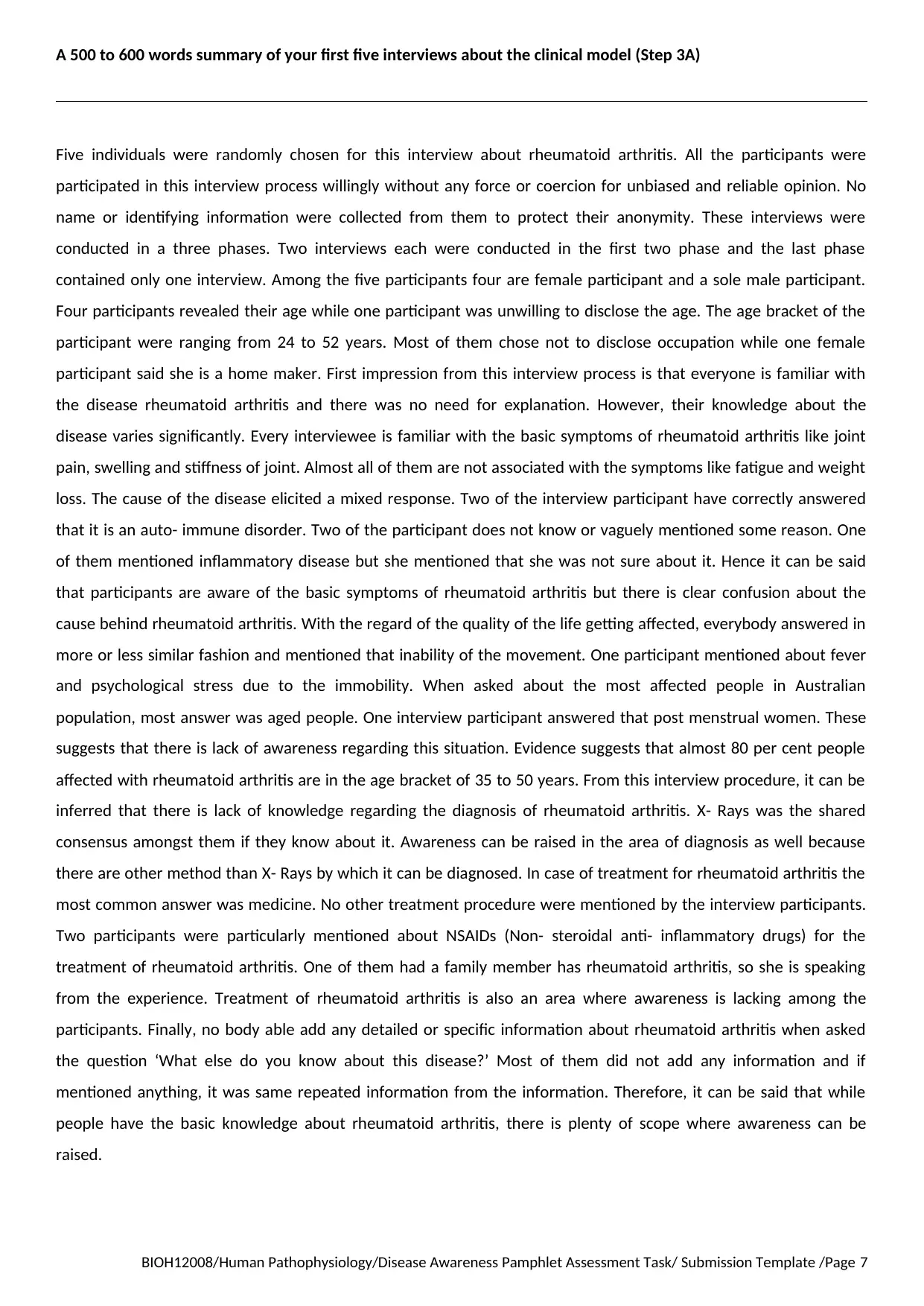
A 500 to 600 words summary of your first five interviews about the clinical model (Step 3A)
Five individuals were randomly chosen for this interview about rheumatoid arthritis. All the participants were
participated in this interview process willingly without any force or coercion for unbiased and reliable opinion. No
name or identifying information were collected from them to protect their anonymity. These interviews were
conducted in a three phases. Two interviews each were conducted in the first two phase and the last phase
contained only one interview. Among the five participants four are female participant and a sole male participant.
Four participants revealed their age while one participant was unwilling to disclose the age. The age bracket of the
participant were ranging from 24 to 52 years. Most of them chose not to disclose occupation while one female
participant said she is a home maker. First impression from this interview process is that everyone is familiar with
the disease rheumatoid arthritis and there was no need for explanation. However, their knowledge about the
disease varies significantly. Every interviewee is familiar with the basic symptoms of rheumatoid arthritis like joint
pain, swelling and stiffness of joint. Almost all of them are not associated with the symptoms like fatigue and weight
loss. The cause of the disease elicited a mixed response. Two of the interview participant have correctly answered
that it is an auto- immune disorder. Two of the participant does not know or vaguely mentioned some reason. One
of them mentioned inflammatory disease but she mentioned that she was not sure about it. Hence it can be said
that participants are aware of the basic symptoms of rheumatoid arthritis but there is clear confusion about the
cause behind rheumatoid arthritis. With the regard of the quality of the life getting affected, everybody answered in
more or less similar fashion and mentioned that inability of the movement. One participant mentioned about fever
and psychological stress due to the immobility. When asked about the most affected people in Australian
population, most answer was aged people. One interview participant answered that post menstrual women. These
suggests that there is lack of awareness regarding this situation. Evidence suggests that almost 80 per cent people
affected with rheumatoid arthritis are in the age bracket of 35 to 50 years. From this interview procedure, it can be
inferred that there is lack of knowledge regarding the diagnosis of rheumatoid arthritis. X- Rays was the shared
consensus amongst them if they know about it. Awareness can be raised in the area of diagnosis as well because
there are other method than X- Rays by which it can be diagnosed. In case of treatment for rheumatoid arthritis the
most common answer was medicine. No other treatment procedure were mentioned by the interview participants.
Two participants were particularly mentioned about NSAIDs (Non- steroidal anti- inflammatory drugs) for the
treatment of rheumatoid arthritis. One of them had a family member has rheumatoid arthritis, so she is speaking
from the experience. Treatment of rheumatoid arthritis is also an area where awareness is lacking among the
participants. Finally, no body able add any detailed or specific information about rheumatoid arthritis when asked
the question ‘What else do you know about this disease?’ Most of them did not add any information and if
mentioned anything, it was same repeated information from the information. Therefore, it can be said that while
people have the basic knowledge about rheumatoid arthritis, there is plenty of scope where awareness can be
raised.
BIOH12008/Human Pathophysiology/Disease Awareness Pamphlet Assessment Task/ Submission Template /Page 7
Five individuals were randomly chosen for this interview about rheumatoid arthritis. All the participants were
participated in this interview process willingly without any force or coercion for unbiased and reliable opinion. No
name or identifying information were collected from them to protect their anonymity. These interviews were
conducted in a three phases. Two interviews each were conducted in the first two phase and the last phase
contained only one interview. Among the five participants four are female participant and a sole male participant.
Four participants revealed their age while one participant was unwilling to disclose the age. The age bracket of the
participant were ranging from 24 to 52 years. Most of them chose not to disclose occupation while one female
participant said she is a home maker. First impression from this interview process is that everyone is familiar with
the disease rheumatoid arthritis and there was no need for explanation. However, their knowledge about the
disease varies significantly. Every interviewee is familiar with the basic symptoms of rheumatoid arthritis like joint
pain, swelling and stiffness of joint. Almost all of them are not associated with the symptoms like fatigue and weight
loss. The cause of the disease elicited a mixed response. Two of the interview participant have correctly answered
that it is an auto- immune disorder. Two of the participant does not know or vaguely mentioned some reason. One
of them mentioned inflammatory disease but she mentioned that she was not sure about it. Hence it can be said
that participants are aware of the basic symptoms of rheumatoid arthritis but there is clear confusion about the
cause behind rheumatoid arthritis. With the regard of the quality of the life getting affected, everybody answered in
more or less similar fashion and mentioned that inability of the movement. One participant mentioned about fever
and psychological stress due to the immobility. When asked about the most affected people in Australian
population, most answer was aged people. One interview participant answered that post menstrual women. These
suggests that there is lack of awareness regarding this situation. Evidence suggests that almost 80 per cent people
affected with rheumatoid arthritis are in the age bracket of 35 to 50 years. From this interview procedure, it can be
inferred that there is lack of knowledge regarding the diagnosis of rheumatoid arthritis. X- Rays was the shared
consensus amongst them if they know about it. Awareness can be raised in the area of diagnosis as well because
there are other method than X- Rays by which it can be diagnosed. In case of treatment for rheumatoid arthritis the
most common answer was medicine. No other treatment procedure were mentioned by the interview participants.
Two participants were particularly mentioned about NSAIDs (Non- steroidal anti- inflammatory drugs) for the
treatment of rheumatoid arthritis. One of them had a family member has rheumatoid arthritis, so she is speaking
from the experience. Treatment of rheumatoid arthritis is also an area where awareness is lacking among the
participants. Finally, no body able add any detailed or specific information about rheumatoid arthritis when asked
the question ‘What else do you know about this disease?’ Most of them did not add any information and if
mentioned anything, it was same repeated information from the information. Therefore, it can be said that while
people have the basic knowledge about rheumatoid arthritis, there is plenty of scope where awareness can be
raised.
BIOH12008/Human Pathophysiology/Disease Awareness Pamphlet Assessment Task/ Submission Template /Page 7
Paraphrase This Document
Need a fresh take? Get an instant paraphrase of this document with our AI Paraphraser

Word count: 567.
BIOH12008/Human Pathophysiology/Disease Awareness Pamphlet Assessment Task/ Submission Template /Page 8
BIOH12008/Human Pathophysiology/Disease Awareness Pamphlet Assessment Task/ Submission Template /Page 8
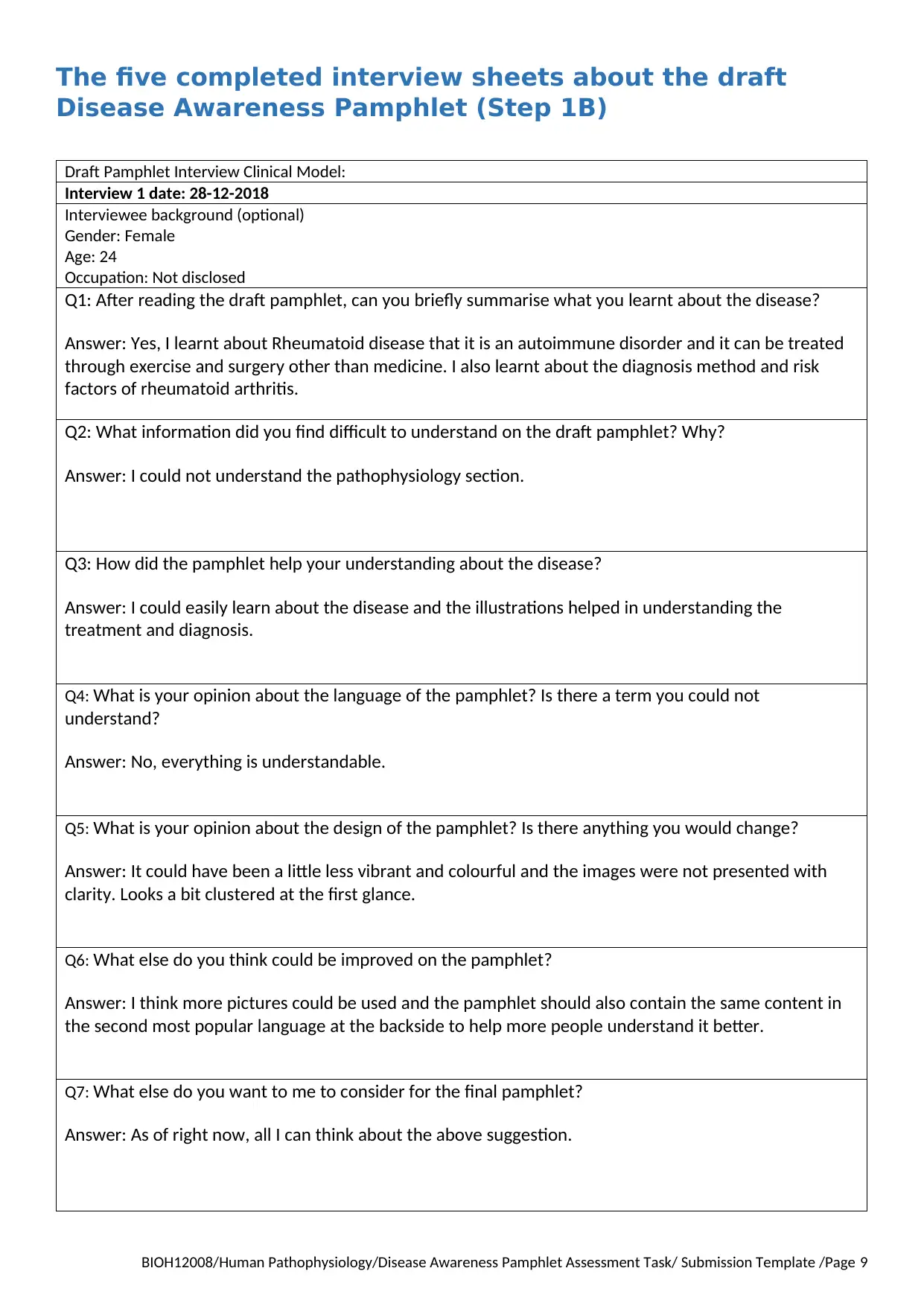
The five completed interview sheets about the draft
Disease Awareness Pamphlet (Step 1B)
Draft Pamphlet Interview Clinical Model:
Interview 1 date: 28-12-2018
Interviewee background (optional)
Gender: Female
Age: 24
Occupation: Not disclosed
Q1: After reading the draft pamphlet, can you briefly summarise what you learnt about the disease?
Answer: Yes, I learnt about Rheumatoid disease that it is an autoimmune disorder and it can be treated
through exercise and surgery other than medicine. I also learnt about the diagnosis method and risk
factors of rheumatoid arthritis.
Q2: What information did you find difficult to understand on the draft pamphlet? Why?
Answer: I could not understand the pathophysiology section.
Q3: How did the pamphlet help your understanding about the disease?
Answer: I could easily learn about the disease and the illustrations helped in understanding the
treatment and diagnosis.
Q4: What is your opinion about the language of the pamphlet? Is there a term you could not
understand?
Answer: No, everything is understandable.
Q5: What is your opinion about the design of the pamphlet? Is there anything you would change?
Answer: It could have been a little less vibrant and colourful and the images were not presented with
clarity. Looks a bit clustered at the first glance.
Q6: What else do you think could be improved on the pamphlet?
Answer: I think more pictures could be used and the pamphlet should also contain the same content in
the second most popular language at the backside to help more people understand it better.
Q7: What else do you want to me to consider for the final pamphlet?
Answer: As of right now, all I can think about the above suggestion.
BIOH12008/Human Pathophysiology/Disease Awareness Pamphlet Assessment Task/ Submission Template /Page 9
Disease Awareness Pamphlet (Step 1B)
Draft Pamphlet Interview Clinical Model:
Interview 1 date: 28-12-2018
Interviewee background (optional)
Gender: Female
Age: 24
Occupation: Not disclosed
Q1: After reading the draft pamphlet, can you briefly summarise what you learnt about the disease?
Answer: Yes, I learnt about Rheumatoid disease that it is an autoimmune disorder and it can be treated
through exercise and surgery other than medicine. I also learnt about the diagnosis method and risk
factors of rheumatoid arthritis.
Q2: What information did you find difficult to understand on the draft pamphlet? Why?
Answer: I could not understand the pathophysiology section.
Q3: How did the pamphlet help your understanding about the disease?
Answer: I could easily learn about the disease and the illustrations helped in understanding the
treatment and diagnosis.
Q4: What is your opinion about the language of the pamphlet? Is there a term you could not
understand?
Answer: No, everything is understandable.
Q5: What is your opinion about the design of the pamphlet? Is there anything you would change?
Answer: It could have been a little less vibrant and colourful and the images were not presented with
clarity. Looks a bit clustered at the first glance.
Q6: What else do you think could be improved on the pamphlet?
Answer: I think more pictures could be used and the pamphlet should also contain the same content in
the second most popular language at the backside to help more people understand it better.
Q7: What else do you want to me to consider for the final pamphlet?
Answer: As of right now, all I can think about the above suggestion.
BIOH12008/Human Pathophysiology/Disease Awareness Pamphlet Assessment Task/ Submission Template /Page 9
⊘ This is a preview!⊘
Do you want full access?
Subscribe today to unlock all pages.

Trusted by 1+ million students worldwide
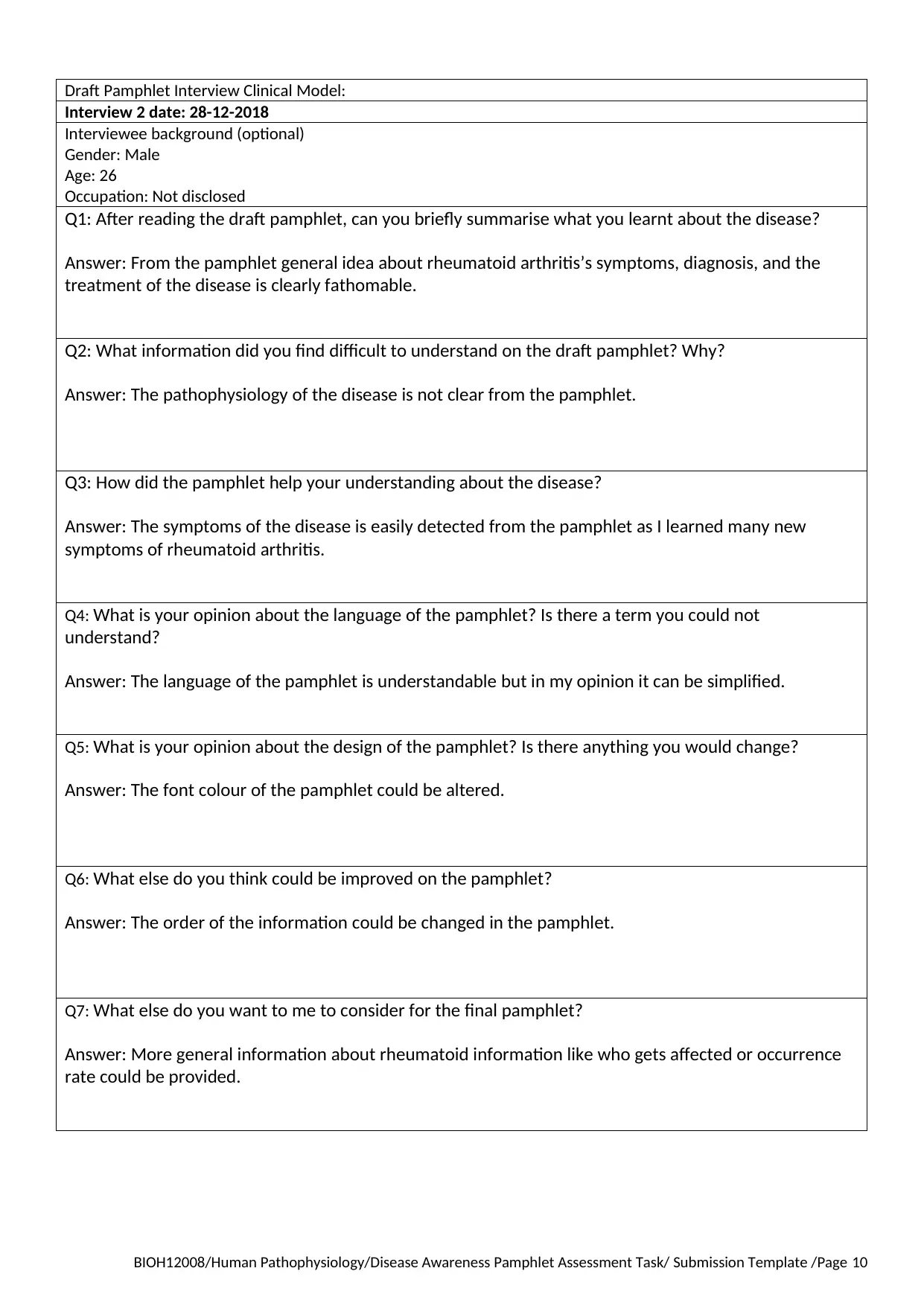
Draft Pamphlet Interview Clinical Model:
Interview 2 date: 28-12-2018
Interviewee background (optional)
Gender: Male
Age: 26
Occupation: Not disclosed
Q1: After reading the draft pamphlet, can you briefly summarise what you learnt about the disease?
Answer: From the pamphlet general idea about rheumatoid arthritis’s symptoms, diagnosis, and the
treatment of the disease is clearly fathomable.
Q2: What information did you find difficult to understand on the draft pamphlet? Why?
Answer: The pathophysiology of the disease is not clear from the pamphlet.
Q3: How did the pamphlet help your understanding about the disease?
Answer: The symptoms of the disease is easily detected from the pamphlet as I learned many new
symptoms of rheumatoid arthritis.
Q4: What is your opinion about the language of the pamphlet? Is there a term you could not
understand?
Answer: The language of the pamphlet is understandable but in my opinion it can be simplified.
Q5: What is your opinion about the design of the pamphlet? Is there anything you would change?
Answer: The font colour of the pamphlet could be altered.
Q6: What else do you think could be improved on the pamphlet?
Answer: The order of the information could be changed in the pamphlet.
Q7: What else do you want to me to consider for the final pamphlet?
Answer: More general information about rheumatoid information like who gets affected or occurrence
rate could be provided.
BIOH12008/Human Pathophysiology/Disease Awareness Pamphlet Assessment Task/ Submission Template /Page 10
Interview 2 date: 28-12-2018
Interviewee background (optional)
Gender: Male
Age: 26
Occupation: Not disclosed
Q1: After reading the draft pamphlet, can you briefly summarise what you learnt about the disease?
Answer: From the pamphlet general idea about rheumatoid arthritis’s symptoms, diagnosis, and the
treatment of the disease is clearly fathomable.
Q2: What information did you find difficult to understand on the draft pamphlet? Why?
Answer: The pathophysiology of the disease is not clear from the pamphlet.
Q3: How did the pamphlet help your understanding about the disease?
Answer: The symptoms of the disease is easily detected from the pamphlet as I learned many new
symptoms of rheumatoid arthritis.
Q4: What is your opinion about the language of the pamphlet? Is there a term you could not
understand?
Answer: The language of the pamphlet is understandable but in my opinion it can be simplified.
Q5: What is your opinion about the design of the pamphlet? Is there anything you would change?
Answer: The font colour of the pamphlet could be altered.
Q6: What else do you think could be improved on the pamphlet?
Answer: The order of the information could be changed in the pamphlet.
Q7: What else do you want to me to consider for the final pamphlet?
Answer: More general information about rheumatoid information like who gets affected or occurrence
rate could be provided.
BIOH12008/Human Pathophysiology/Disease Awareness Pamphlet Assessment Task/ Submission Template /Page 10
Paraphrase This Document
Need a fresh take? Get an instant paraphrase of this document with our AI Paraphraser
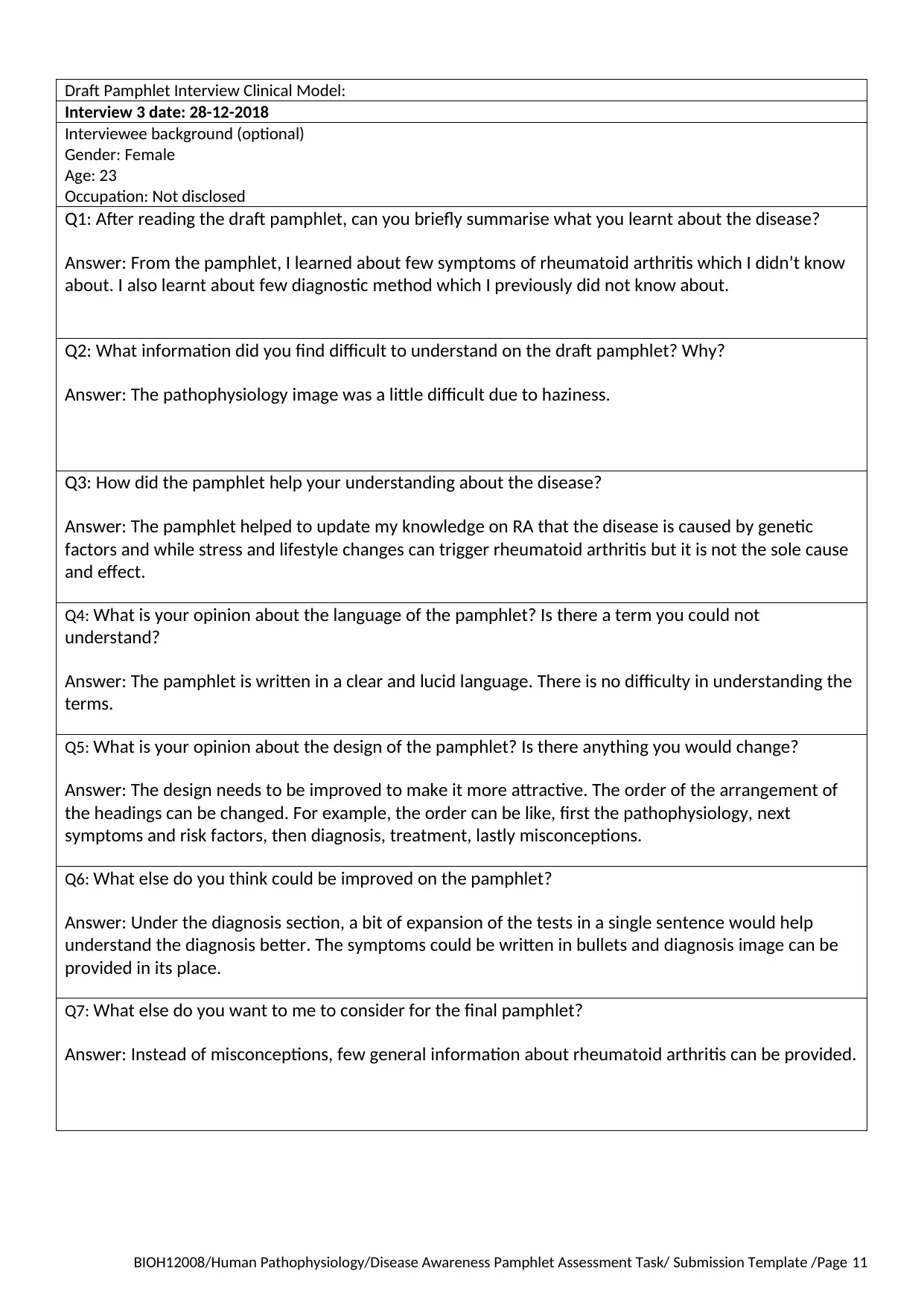
Draft Pamphlet Interview Clinical Model:
Interview 3 date: 28-12-2018
Interviewee background (optional)
Gender: Female
Age: 23
Occupation: Not disclosed
Q1: After reading the draft pamphlet, can you briefly summarise what you learnt about the disease?
Answer: From the pamphlet, I learned about few symptoms of rheumatoid arthritis which I didn’t know
about. I also learnt about few diagnostic method which I previously did not know about.
Q2: What information did you find difficult to understand on the draft pamphlet? Why?
Answer: The pathophysiology image was a little difficult due to haziness.
Q3: How did the pamphlet help your understanding about the disease?
Answer: The pamphlet helped to update my knowledge on RA that the disease is caused by genetic
factors and while stress and lifestyle changes can trigger rheumatoid arthritis but it is not the sole cause
and effect.
Q4: What is your opinion about the language of the pamphlet? Is there a term you could not
understand?
Answer: The pamphlet is written in a clear and lucid language. There is no difficulty in understanding the
terms.
Q5: What is your opinion about the design of the pamphlet? Is there anything you would change?
Answer: The design needs to be improved to make it more attractive. The order of the arrangement of
the headings can be changed. For example, the order can be like, first the pathophysiology, next
symptoms and risk factors, then diagnosis, treatment, lastly misconceptions.
Q6: What else do you think could be improved on the pamphlet?
Answer: Under the diagnosis section, a bit of expansion of the tests in a single sentence would help
understand the diagnosis better. The symptoms could be written in bullets and diagnosis image can be
provided in its place.
Q7: What else do you want to me to consider for the final pamphlet?
Answer: Instead of misconceptions, few general information about rheumatoid arthritis can be provided.
BIOH12008/Human Pathophysiology/Disease Awareness Pamphlet Assessment Task/ Submission Template /Page 11
Interview 3 date: 28-12-2018
Interviewee background (optional)
Gender: Female
Age: 23
Occupation: Not disclosed
Q1: After reading the draft pamphlet, can you briefly summarise what you learnt about the disease?
Answer: From the pamphlet, I learned about few symptoms of rheumatoid arthritis which I didn’t know
about. I also learnt about few diagnostic method which I previously did not know about.
Q2: What information did you find difficult to understand on the draft pamphlet? Why?
Answer: The pathophysiology image was a little difficult due to haziness.
Q3: How did the pamphlet help your understanding about the disease?
Answer: The pamphlet helped to update my knowledge on RA that the disease is caused by genetic
factors and while stress and lifestyle changes can trigger rheumatoid arthritis but it is not the sole cause
and effect.
Q4: What is your opinion about the language of the pamphlet? Is there a term you could not
understand?
Answer: The pamphlet is written in a clear and lucid language. There is no difficulty in understanding the
terms.
Q5: What is your opinion about the design of the pamphlet? Is there anything you would change?
Answer: The design needs to be improved to make it more attractive. The order of the arrangement of
the headings can be changed. For example, the order can be like, first the pathophysiology, next
symptoms and risk factors, then diagnosis, treatment, lastly misconceptions.
Q6: What else do you think could be improved on the pamphlet?
Answer: Under the diagnosis section, a bit of expansion of the tests in a single sentence would help
understand the diagnosis better. The symptoms could be written in bullets and diagnosis image can be
provided in its place.
Q7: What else do you want to me to consider for the final pamphlet?
Answer: Instead of misconceptions, few general information about rheumatoid arthritis can be provided.
BIOH12008/Human Pathophysiology/Disease Awareness Pamphlet Assessment Task/ Submission Template /Page 11
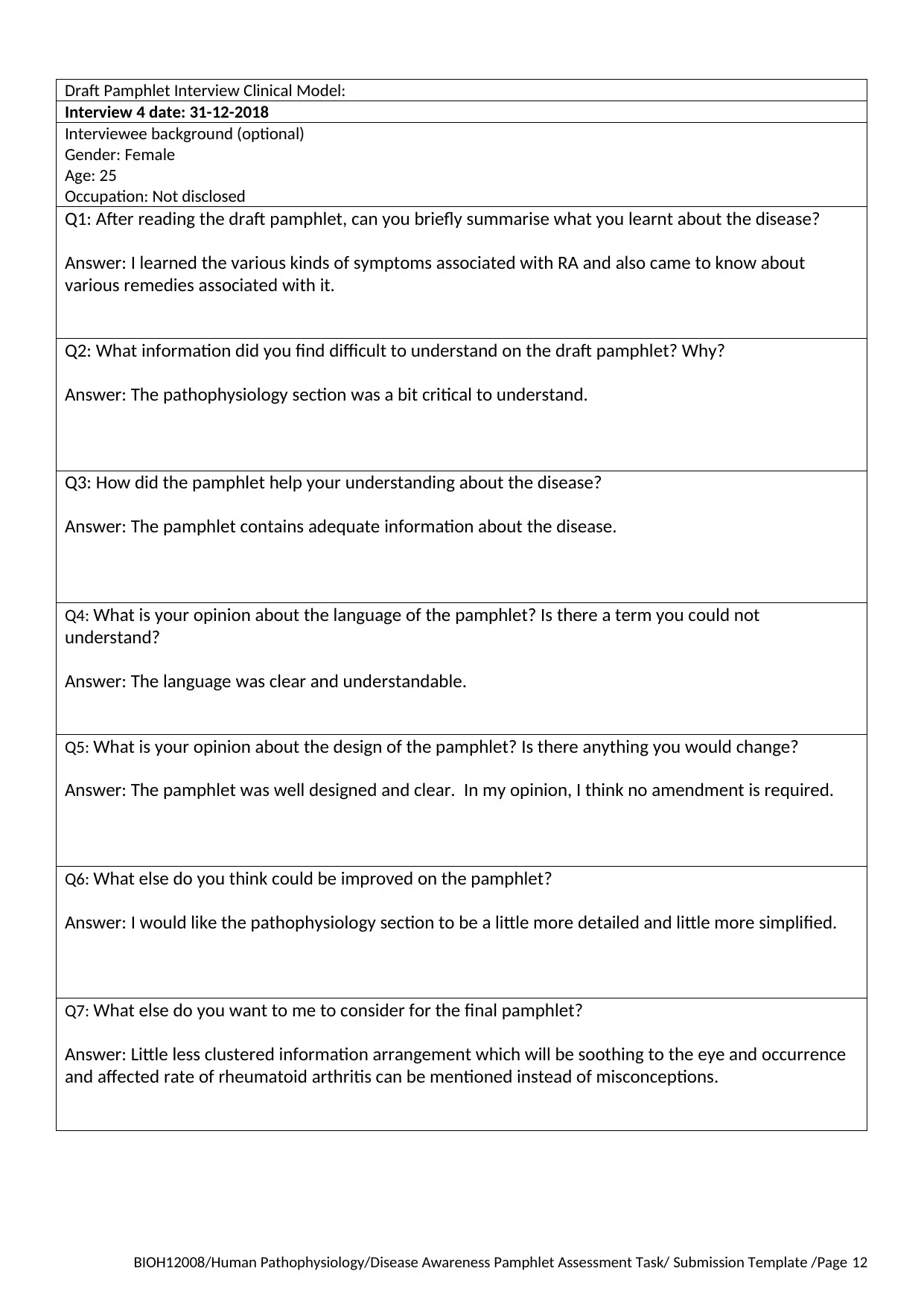
Draft Pamphlet Interview Clinical Model:
Interview 4 date: 31-12-2018
Interviewee background (optional)
Gender: Female
Age: 25
Occupation: Not disclosed
Q1: After reading the draft pamphlet, can you briefly summarise what you learnt about the disease?
Answer: I learned the various kinds of symptoms associated with RA and also came to know about
various remedies associated with it.
Q2: What information did you find difficult to understand on the draft pamphlet? Why?
Answer: The pathophysiology section was a bit critical to understand.
Q3: How did the pamphlet help your understanding about the disease?
Answer: The pamphlet contains adequate information about the disease.
Q4: What is your opinion about the language of the pamphlet? Is there a term you could not
understand?
Answer: The language was clear and understandable.
Q5: What is your opinion about the design of the pamphlet? Is there anything you would change?
Answer: The pamphlet was well designed and clear. In my opinion, I think no amendment is required.
Q6: What else do you think could be improved on the pamphlet?
Answer: I would like the pathophysiology section to be a little more detailed and little more simplified.
Q7: What else do you want to me to consider for the final pamphlet?
Answer: Little less clustered information arrangement which will be soothing to the eye and occurrence
and affected rate of rheumatoid arthritis can be mentioned instead of misconceptions.
BIOH12008/Human Pathophysiology/Disease Awareness Pamphlet Assessment Task/ Submission Template /Page 12
Interview 4 date: 31-12-2018
Interviewee background (optional)
Gender: Female
Age: 25
Occupation: Not disclosed
Q1: After reading the draft pamphlet, can you briefly summarise what you learnt about the disease?
Answer: I learned the various kinds of symptoms associated with RA and also came to know about
various remedies associated with it.
Q2: What information did you find difficult to understand on the draft pamphlet? Why?
Answer: The pathophysiology section was a bit critical to understand.
Q3: How did the pamphlet help your understanding about the disease?
Answer: The pamphlet contains adequate information about the disease.
Q4: What is your opinion about the language of the pamphlet? Is there a term you could not
understand?
Answer: The language was clear and understandable.
Q5: What is your opinion about the design of the pamphlet? Is there anything you would change?
Answer: The pamphlet was well designed and clear. In my opinion, I think no amendment is required.
Q6: What else do you think could be improved on the pamphlet?
Answer: I would like the pathophysiology section to be a little more detailed and little more simplified.
Q7: What else do you want to me to consider for the final pamphlet?
Answer: Little less clustered information arrangement which will be soothing to the eye and occurrence
and affected rate of rheumatoid arthritis can be mentioned instead of misconceptions.
BIOH12008/Human Pathophysiology/Disease Awareness Pamphlet Assessment Task/ Submission Template /Page 12
⊘ This is a preview!⊘
Do you want full access?
Subscribe today to unlock all pages.

Trusted by 1+ million students worldwide
1 out of 15
Related Documents
Your All-in-One AI-Powered Toolkit for Academic Success.
+13062052269
info@desklib.com
Available 24*7 on WhatsApp / Email
![[object Object]](/_next/static/media/star-bottom.7253800d.svg)
Unlock your academic potential
Copyright © 2020–2025 A2Z Services. All Rights Reserved. Developed and managed by ZUCOL.





